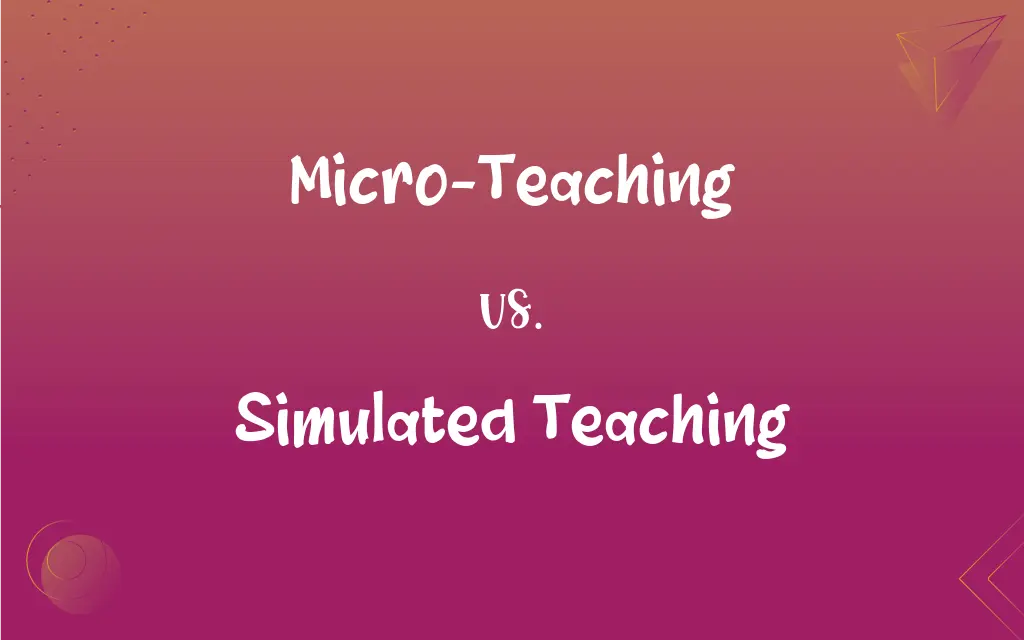Micro-Teaching vs. Simulated Teaching: What's the Difference?
Edited by Aimie Carlson || By Janet White || Published on January 24, 2024
Micro-teaching is a teacher training method focusing on practicing teaching skills in brief, structured sessions, whereas simulated teaching involves practicing in an artificially created teaching environment.

Key Differences
Micro-teaching is a scaled-down teaching encounter where trainee teachers practice specific teaching skills, like questioning or explaining, in a short, focused session. Simulated teaching, however, involves creating an artificial classroom setting where various teaching scenarios are enacted to train teachers.
In micro-teaching, feedback is a crucial component, with peers and instructors providing immediate critique and suggestions for improvement. In simulated teaching, the emphasis is more on experiencing diverse classroom situations, often with actors playing the role of students.
The sessions in micro-teaching are typically 5 to 10 minutes long, focusing intensely on one or two aspects of teaching. Simulated teaching sessions can be longer, providing a more extensive experience of a classroom environment, including dealing with unexpected student behavior.
Micro-teaching is often used in teacher education programs to refine specific teaching techniques in a controlled, supportive environment. Simulated teaching is used not only for skill refinement but also for preparing teachers to handle real-world classroom challenges, including student diversity and classroom management.
The goal of micro-teaching is to build confidence and competence in teaching skills through repetition and refinement. Simulated teaching aims to prepare teachers for the complexities of real classrooms by exposing them to a wide range of teaching and learning scenarios.
ADVERTISEMENT
Comparison Chart
Focus
Specific teaching skills practice
Overall classroom environment practice
Feedback Mechanism
Immediate and specific feedback
General feedback on handling scenarios
Duration of Sessions
Short, typically 5-10 minutes
Longer, more comprehensive sessions
Primary Use
Skill refinement
Preparation for real-world challenges
Teaching Environment
Controlled and supportive
Artificially created, diverse scenarios
ADVERTISEMENT
Micro-Teaching and Simulated Teaching Definitions
Micro-Teaching
Short, concentrated teaching practices for trainee teachers.
Micro-teaching helped her master effective classroom communication.
Simulated Teaching
Role-playing various classroom challenges for teacher training.
He gained confidence in student engagement through simulated teaching.
Micro-Teaching
Controlled practice setting for honing teaching methodologies.
Micro-teaching sessions allowed her to experiment with different teaching aids.
Simulated Teaching
Creating realistic teaching environments for practical experience.
Simulated teaching sessions exposed her to the complexities of classroom management.
Micro-Teaching
Practice of teaching skills in brief, structured sessions.
She improved her questioning technique through micro-teaching sessions.
Simulated Teaching
An approach to train teachers by enacting real-life classroom situations.
Through simulated teaching, she learned to adapt her lessons to different learning styles.
Micro-Teaching
A method focusing on refining specific aspects of teaching.
In his micro-teaching session, he focused on developing engaging lesson plans.
Simulated Teaching
Practice teaching in an artificially created classroom setting.
Simulated teaching helped him prepare for handling diverse student behaviors.
Micro-Teaching
A teacher training technique emphasizing skill development.
He used micro-teaching to enhance his lecture delivery skills.
Simulated Teaching
Training method using mock classroom scenarios for teacher preparation.
Her simulated teaching experience included managing a disruptive classroom.
FAQs
How long do micro-teaching sessions usually last?
Micro-teaching sessions are typically short, lasting about 5 to 10 minutes.
Can simulated teaching include dealing with disruptive students?
Yes, simulated teaching often includes scenarios like handling disruptive students.
What is the main purpose of micro-teaching?
The main purpose of micro-teaching is to practice and refine specific teaching skills.
Is micro-teaching beneficial for experienced teachers?
Yes, even experienced teachers can benefit from micro-teaching to hone specific skills.
Do simulated teaching sessions use real students?
Simulated teaching sessions often use actors or peers to play the role of students.
What skills can be developed through micro-teaching?
Skills like questioning, explaining, lesson planning, and classroom interaction can be developed through micro-teaching.
Can simulated teaching help in learning classroom management?
Yes, simulated teaching is effective for learning various aspects of classroom management.
What does simulated teaching primarily focus on?
Simulated teaching focuses on preparing teachers for real-life classroom situations.
Is feedback a crucial part of micro-teaching?
Yes, immediate and specific feedback is a key element of micro-teaching.
Is micro-teaching used in online teacher training?
Yes, micro-teaching can be adapted for online teacher training programs.
Does simulated teaching prepare teachers for diverse classrooms?
Yes, simulated teaching prepares teachers for the diversity found in real classrooms.
Can simulated teaching involve emergency situations?
Simulated teaching can include emergency scenarios to prepare teachers for unexpected events.
Can micro-teaching be used for team teaching practice?
Micro-teaching can be adapted for practicing team teaching techniques.
How does simulated teaching benefit new teachers?
Simulated teaching gives new teachers practical experience and confidence before entering a real classroom.
How realistic are the scenarios in simulated teaching?
Scenarios in simulated teaching are designed to be as realistic as possible.
Are real classroom materials used in simulated teaching?
Yes, real or realistic classroom materials are often used in simulated teaching.
How is feedback given in micro-teaching?
Feedback in micro-teaching is usually given immediately after the session by peers or instructors.
Is technology integrated into simulated teaching?
Technology is often integrated into simulated teaching to enhance the realism of scenarios.
Do universities commonly use micro-teaching for teacher training?
Yes, many universities incorporate micro-teaching in their teacher training programs.
Can micro-teaching sessions be recorded for further analysis?
Yes, recording micro-teaching sessions for later analysis is a common practice.
About Author
Written by
Janet WhiteJanet White has been an esteemed writer and blogger for Difference Wiki. Holding a Master's degree in Science and Medical Journalism from the prestigious Boston University, she has consistently demonstrated her expertise and passion for her field. When she's not immersed in her work, Janet relishes her time exercising, delving into a good book, and cherishing moments with friends and family.
Edited by
Aimie CarlsonAimie Carlson, holding a master's degree in English literature, is a fervent English language enthusiast. She lends her writing talents to Difference Wiki, a prominent website that specializes in comparisons, offering readers insightful analyses that both captivate and inform.






































































